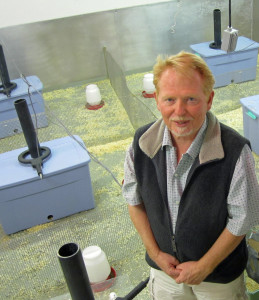
Variables in previous tests focusing on the toxicity of both fructose and table sugar have proven inconclusive.
Wayne Potts, a biologist at the University of Utah, is improving on the accuracy of sugar toxicity tests.
Professor Wayne Potts specializes in the ecology and evolution of host-pathogen interactions. During these studies he discovered that house mice in small semi-natural populations can reveal health declines from many treatments, which are often missed by conventional toxicity assessment methodologies. This is largely because these mice compete vigorously over territories, resources, mates and reproductive opportunities. Thus, treatments that reduce health are revealed with great sensitivity and breadth. Recently, he has applied this approach to study adverse health consequences due to the consumption of added sugar at human relevant levels. Professor Potts received his PhD from the University of Washington in 1986. He was an NIH post-doctoral fellow before accepting his first faculty position in the School of Medicine at the University of Florida in 1991. In 1996 he moved to the Biology Department at the University of Utah. Professor Potts’ cross-training in both evolution and biomedicine has led to his interdisciplinary approaches, which have produced important discoveries that were unlikely to have been made without this cross-pollinating synergism.
Sugar Toxicity Tests
![]()
Diabetes and other human metabolic diseases have been tied to eating processed foods with added sugars, largely based on studies in rodents. But those studies have been criticized because they used artificially high levels of sugars. In 2013, my laboratory demonstrated for the first time adverse health effects in mice that were fed sugar at levels proportional to what many people eat. We did that using a sensitive new toxicity test we have developed for detecting health consequences in mice from any kind of substance or medication.
 It is known as an Organismal Performance Assay. In our latest study, we used the new test to address the long-standing debate over whether there are different health effects from consuming either of the two common types of added sugar: high-fructose corn syrup or sucrose. We fed wild-type mice a diet where 25 percent of their calories came from either sucrose or a fructose-glucose mixture like that found in high-fructose corn syrup.
It is known as an Organismal Performance Assay. In our latest study, we used the new test to address the long-standing debate over whether there are different health effects from consuming either of the two common types of added sugar: high-fructose corn syrup or sucrose. We fed wild-type mice a diet where 25 percent of their calories came from either sucrose or a fructose-glucose mixture like that found in high-fructose corn syrup.
The mice started eating one or the other of those diets when they were weaned. Then, after 40 weeks, 160 mice — half from each diet — were released into “mouse barns,” which are seminatural indoor enclosures used for our new toxicity test. In the mouse barns, the animals spent 32 weeks competing for territories, food and mates. We found that during the experiment, females on high-fructose corn syrup died at almost twice the rate as female mice on the sucrose diet. They also produced 26 percent fewer offspring than females fed sucrose.
No differences in survival, reproduction or social dominance were observed in males. This study provides evidence that high-fructose corn syrup is more harmful to the health of female mice than equal amounts of sucrose. To confirm if these sugars have different health effects in people, researchers must identify the mechanisms responsible for such differences in rodents. This study shows how our sensitive toxicity test offers a powerful new approach for identifying adverse health consequences from any suspected toxic substance.
Read More: U News Center: Fructose More Toxic than Table Sugar in Mice

Comments
One response to “Wayne Potts, University of Utah – Sugar Toxicity Tests”
conquest of paradise